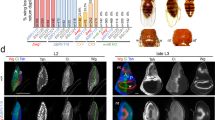Summary
It has been known for many years that when a wing disc ofDrosophila is bisected, and the fragments cultured in adult females, regulation occurs and either a complete disc is regenerated or the fragment is duplicated. We have investigated how this regeneration process occurs. To establish which cells contribute to the regenerate, and thus determine if regeneration is the result of epimorphic regulation, fragments of discs, after culture in an adult for one to five days, were exposed to3H-thymidine to label replicating cells. Imaginal discs, both whole and as regenerating fragments, undergo some DNA replication which is distributed throughout the disc, but cut discs frequently show clusters of labelled cells around the wound, indicating that regeneration is probably epimorphic.
Similar content being viewed by others
References
Bryant PJ (1971) Regeneration and duplication following operations in situ on the imaginal discs ofDrosophila melanogaster. Dev Biol 26:637–651
Bryant PJ (1975) Pattern formation in the imaginal wing disc ofDrosophila melanogaster: Fate map, regeneration and duplication. J Exp Zool 193:49–78
Chan LN, Gehring W (1971) Determination of blastoderm cells inDrosophila melanogaster. Proc Natl Acad Sci USA 68:2217–2221
French V, Bryant PJ, Bryant SV (1976) A theory of pattern regulation in epimorphic fields. Science 193:969–981
Girton JR, Russell MA (1980) A clonal analysis of pattern duplication in a temperature-sensitive cell-lethal mutant ofDrosophila melanogaster. Dev Biol 77:1–21
James A, Bownes M, Glenn S (1980) The re-establishment of pattern elements in regenerating imaginal wing discs ofDrosophila melanogaster. DIS in press
Meer JM van der, Ouweneel WJ (1974) Differentiation capacities of the dorsal metathoracic (haltere) disc ofDrosophila melanogaster. II Regeneration and duplication. Wilhelm Roux's Archives 174:361–373
Poodry CA, Schneiderman HA (1970) Ultrastructure of the developing leg ofDrosophila melanogaster. Wilhelm Roux's Archives 166:1–44
Postlethwait JH, Poodry CA, Schneiderman HA (1971) Cellular dynamics of pattern duplication in imaginal discs ofDrosophila melanogaster. Dev Biol 26:125–132
Reinhardt CA, Hodgkin NM, Bryant PJ (1977) Wound healing in the imaginal discs ofDrosophila 1. Scanning electron microscopy of normal and healing wing discs. Dev Biol 60:238–253
Schubiger G (1971) Regeneration, duplication and transdetermination in fragments of the leg disc ofDrosophila melanogaster. Dev Biol 26:277–295
Schubiger G, Abbot L, Karpen G (1979) Clonal analysis of regenerating and duplicatingDrosophila imaginal discs. Abstracts of the 6th European Drosophila Research Conference. Kupari-Yugoslavia.
Ulrich E (1971) Cell lineage, determination and regeneration in the female genital disc ofDrosophila melanogaster. Wilhelm Roux's Archives 167:64–82
Wildermuth H (1968) Autoradiographische Untersuchungen zum Vermehrungsmuster der Zellen in proliferierenden Rüsselprimorden vonDrosophila melanogaster. Dev Biol 18:1–13
Author information
Authors and Affiliations
Rights and permissions
About this article
Cite this article
Dale, L., Bownes, M. Is regeneration inDrosophila the result of epimorphic regulation?. Wilhelm Roux' Archiv 189, 91–96 (1980). https://doi.org/10.1007/BF00848497
Received:
Accepted:
Issue Date:
DOI: https://doi.org/10.1007/BF00848497




